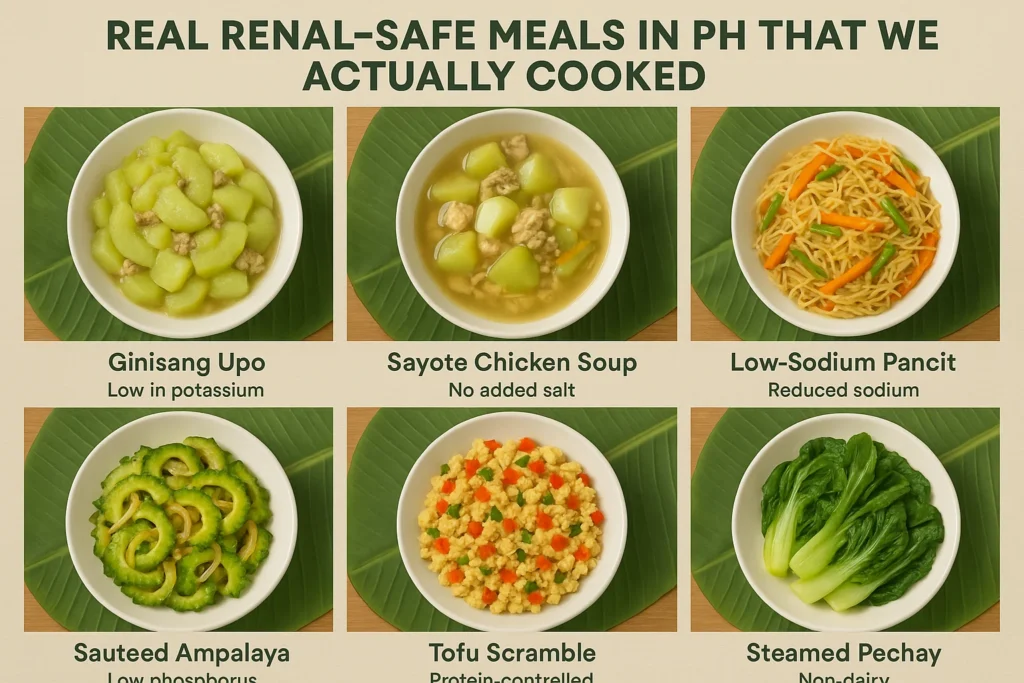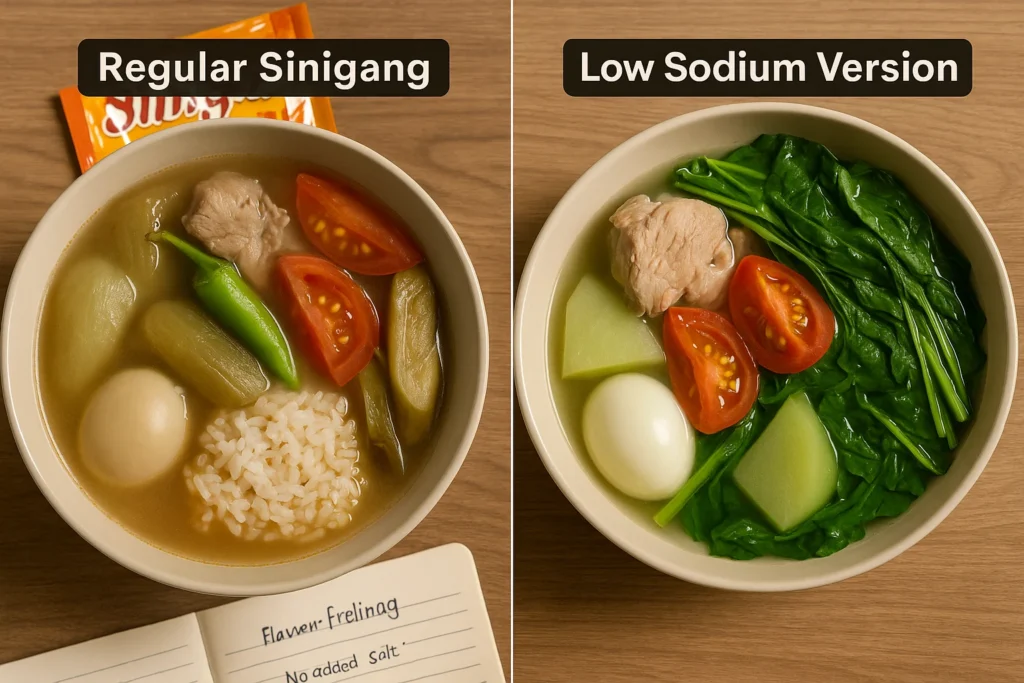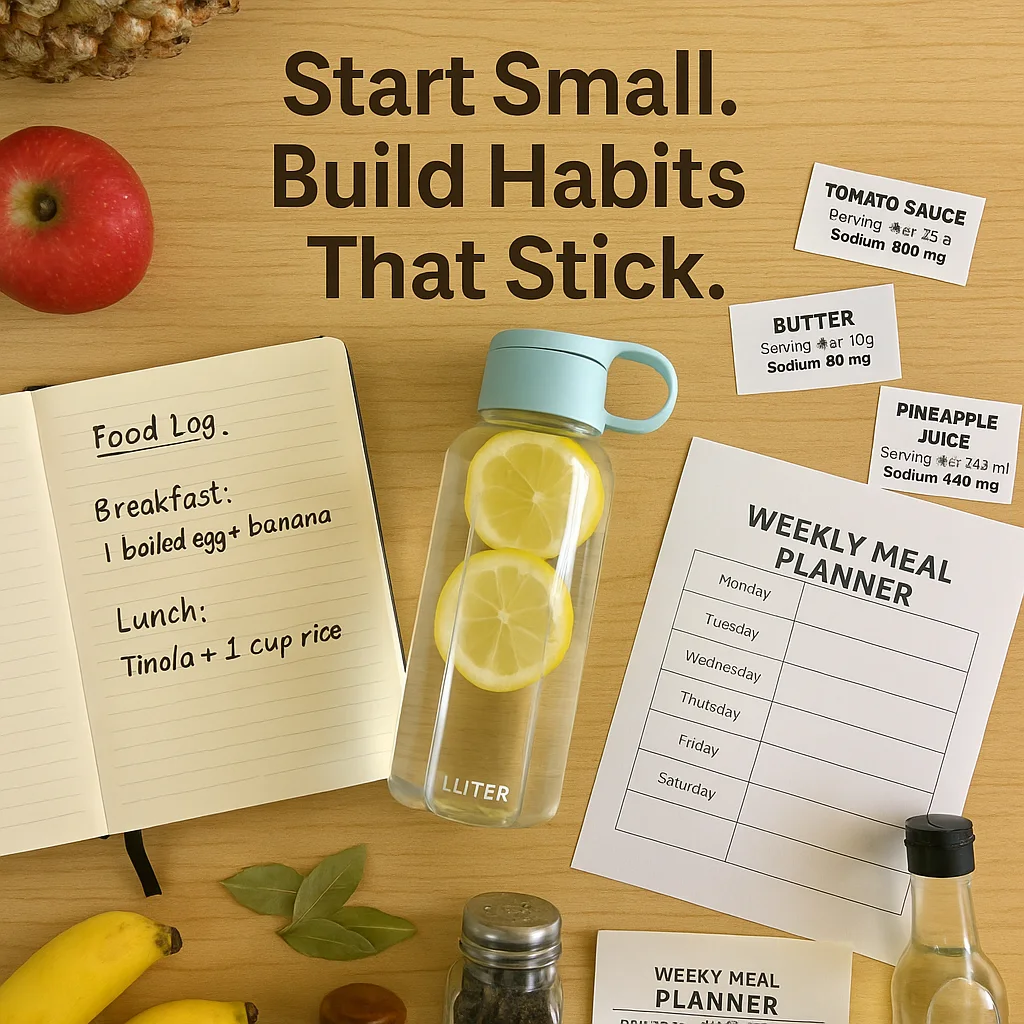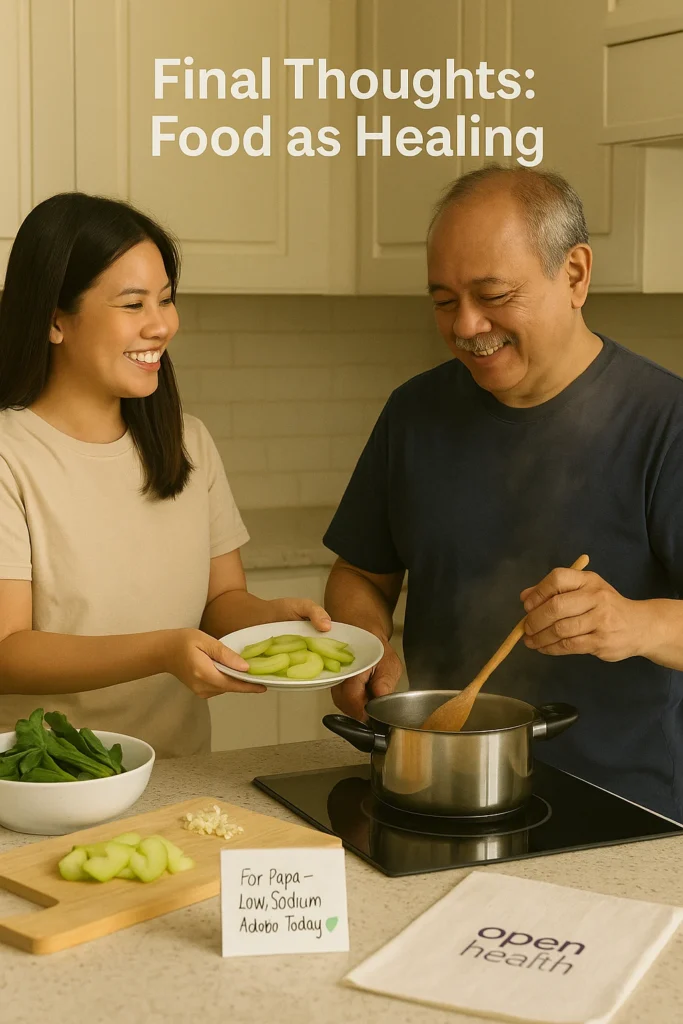Table of Contents
Kidney-friendly Filipino diet meals are more than possible—they’re delicious, healing, and made with love. Whether you’re managing CKD or supporting a loved one, small changes to traditional dishes can make a big difference. By following key CKD nutrition tips and incorporating low sodium Filipino food alternatives, you can support kidney health without giving up the flavors you love.
For more information on how kidney disease affects diet, visit the National Kidney Foundation’s Nutrition Guide.
“One out of 10 Filipinos may have chronic kidney disease (CKD), and most don’t even know it.”
— Philippine Society of Nephrology
That’s not just a number. That’s someone’s mother, uncle, best friend—or maybe even you.
When my client was diagnosed with early-stage CKD, it shook him. He didn’t look sick. He felt fine. But his labs told a different story. The doctor sat him down and said, “No more salty food. Less meat. Watch the potassium.” He remembers looking at his weekly meal plan and thinking—how do you even do that in a Filipino household?
Let me tell you—it’s not easy at first. But it’s not impossible. You don’t have to give up every favorite dish. You just have to tweak it. This post is for anyone looking for a real-world, kidney-friendly Filipino diet—the kind that fits your lifestyle and still tastes like home.
What Makes a Kidney-Friendly Filipino Diet?
When your kidneys aren’t working well, they can’t get rid of waste the way they should. That means we need to ease their workload. A good kidney-friendly Filipino diet does just that—using local ingredients and realistic changes.
The basic rules? Lower sodium, control protein, watch potassium and phosphorus, and manage fluids. Sounds complicated, right? But here’s what it would look like for you in real life:
- Swap bagoong and patis for natural herbs, calamansi, and vinegar
- Use leaner cuts of pork or chicken—and serve smaller portions
- Add more gulay like upo, sayote, and labanos (all low in potassium!)
- Cut back on processed meats—goodbye, longganisa and tocino, at least for now
These are general tips to creating a kidney-friendly Filipino diet that can work for you but remember to always consult a dietitian. YOU% offers online nutrition services no matter where you’re from (imagine having your own personal dietitian!).
It’s not just about removing ingredients. It was about replacing them with better choices. Instead of instant noodles, you can start cooking mami with fresh chicken breast, homemade broth, and thin pechay. Less seasoning packets. Still flavorful, still satisfying, and very much aligned with a kidney-friendly Filipino diet.
Another big win can be how you handle condiments. This can be a turning point in your kidney-friendly Filipino diet journey. Instead of soy sauce, lean towards dipping sauces made with calamansi, crushed garlic, and a tiny dash of vinegar. It will amaze you how those simple swaps added so much flavor without compromising kidney health. You can even make your own salt-free adobo mix using bay leaves, peppercorns, and apple cider vinegar—one of the easiest and most impactful CKD nutrition tips our clients have picked up from working with YOU%. These little hacks make a big difference in lowering sodium, while keeping Filipino meals comforting and familiar.
Even small things helped. Things like removing the skin from chicken, grilling or steaming more instead of frying everything. And watching portions more closely—especially the your viand-to-rice ratio, which is often way off in a typical Filipino plate.
One surprising thing you’ll notice? The food won’t taste bland. Once your taste buds adjust, everything will feel lighter and more natural. And when my client’s follow-up blood work came back and had improved, they knew they were on the right path. It gave them proof that a kidney-friendly Filipino diet wasn’t just doable—it was effective.
This is what a kidney-friendly Filipino diet looks like in real homes. It’s not about perfect meals—it’s about daily decisions. Replacing instead of removing. Adjusting, not giving up. And always keeping flavor at the heart of the plate.
Don’t be afraid to get creative in the kitchen. Start slow. Swap one ingredient. Try one new recipe. Look at what’s already in your pantry and think, “How can I make this kidney-safe without losing the taste?”
Over time, your body—and your kidneys—will thank you. Your energy will improve. Your digestion will feel better. And most importantly, you’ll start to enjoy meals again, without the guilt or stress.
It’s not a quick fix. But it’s one of the most loving things you can do for yourself or someone you care for. With a kidney-friendly Filipino diet, every meal becomes a step toward healing, not just eating.
Real Renal-Safe Meals in PH That Even You Can Cook

We make sure our clients don’t feel like they’re on some depressing “diet.” We just help them make adjustments. They’ve learned (and you can too!) that a kidney-friendly Filipino diet doesn’t mean eating bland, boring meals. It means choosing wisely and being creative with what’s already in your kitchen.
Here are a few renal-safe meals in PH that worked for our clients—and they might work for you, too:
1. Ginisang Upo with Ground Chicken (no fish sauce)
Upo is low in potassium and super affordable. Ground chicken gives you protein without overloading the kidneys. They use garlic, onions, a splash of vinegar, and salt-free seasoning like herbs and a bit of turmeric. My client used to be skeptical, but now he actually makes this dish daily.
2. Sayote and Chicken Soup
Think of it as tinola reimagined. We use sayote—another kidney-friendly vegetable—and less broth than usual. Instead of fish sauce, we add ginger, onions, and a dash of calamansi. It’s warm, comforting, and light on the kidneys.
3. Grilled Eggplant with Garlic and Vinegar Dip
We roast the eggplant until soft, then mash it slightly and serve with garlic and a vinegar-based dip. Instead of soy sauce, our clients use calamansi with a bit of sugar-free ketchup. This dish is always on their weekly menu. It’s THAT good.
4. Adobo with a Twist
Yes, you can still enjoy adobo! We use lean pork or skinless chicken thighs, skip the soy sauce, and flavor it with vinegar, garlic, bay leaf, and a little olive oil. Sometimes we throw in a bit of chopped sayote to stretch the serving and add more fiber. The result? Familiar taste, but lighter on the kidneys.
5. Breakfast Tofu Scramble
This one was a surprise hit for most of our clients. Crumble firm tofu, sauté with garlic, tomatoes, and onion, and serve it with a side of boiled camote. It’s low in phosphorus, plant-based, and surprisingly filling.
6. Homemade Low-Sodium Pancit
Instead of using instant mixes or pre-cooked meats, we prepare pancit with lots of carrots, cabbage, and sayote. Use shredded boiled chicken breast, low-sodium broth, and a garlic-onion base. No soy sauce, no problem—it still tastes like comfort.
Each of these meals helped our clients feel like they weren’t missing out. The key was not to throw everything out, but to make thoughtful changes that kept the spirit of their food alive.
The more you embrace these ideas for renal-safe meals in PH, the more empowered you will feel. A lot of our clients never cooked before but now? Cooking has became something they look forward to, not something they dreaded.
A kidney-friendly Filipino diet can be colorful, rich in flavor, and deeply satisfying. You just have to give it a chance—and a little creativity in the kitchen goes a long way.
Low Sodium Filipino Food Doesn’t Have to Be Boring

Salt is everywhere in the Filipino cuisine. From canned sardines to street barbecue marinades—it’s hiding in plain sight. And for people managing CKD, sodium is one of the first things that needs attention. Excess salt puts unnecessary strain on the kidneys, leading to fluid retention and even higher blood pressure.
But once you become more aware, you start making changes that won’t feel like punishment. We help clients realize that low sodium Filipino food could still be full of flavor if they leaned into the right ingredients and techniques.
One tip? Dry toasting spices like paminta and bawang before adding them to dishes. They release more aroma and flavor this way—and you won’t even miss the salt.
If you’re new to low sodium Filipino food, start by making one dish per day with no added salt. You’ll start noticing just how reliant we are on processed flavorings—and how much better fresh food can taste.
Another thing clients learned? Don’t double season. A lot of times, people will marinate meat in soy sauce, then cook it in broth, then add salt again at the end. That’s a lot of sodium layering! When you remove just one of those steps—or swap it with herbs and citrus—you significantly reduce the total load.
You can also begin batch-prepping salt-free bases. Like sautéed garlic, onions, and tomatoes, stored in the fridge. This will become the starter for soups, stir-fries, and sauces. It will add instant flavor without having to reach for the salt shaker.
Even the way our clients cooked changed. Steaming and grilling brought out the natural sweetness of vegetables like kalabasa, eggplant, and okra. With a drizzle of olive oil and a sprinkle of cracked pepper, they didn’t need anything else.
Snacks? Keep it simple. Sliced cucumber with vinegar dip. Watermelon or pineapple (if potassium levels allowed). Unsalted popcorn with paprika. These little swaps kept cravings in check and supported a kidney-friendly Filipino diet day after day.
Salt doesn’t have to be the star of every plate. Once you give your taste buds a chance to adjust, you’ll find that real food tastes even better.
It’s not about eliminating joy from your meals. It’s about finding new ways to enjoy the flavors of home—while protecting your kidneys at the same time.
Small change. Big difference. That’s the beauty of low sodium Filipino food done right.
CKD Nutrition Tips Our Clients Wish They Knew Earlier

When our clients were first diagnosed, they were SO overwhelmed and didn’t know where to begin. They were scared of doing it wrong. Everything felt overwhelming—the many restrictions, so much medical advice, and yet not a lot of real-life examples of how to actually eat.
One of the most important CKD nutrition tips they learned from us that we’ll share with you? Start small. Build habits that stick.
- Always read the labels. They know how to scan the back of cans. You’d be shocked how many supposedly healthy snacks are loaded with salt.
- Avoid high-potassium fruits like bananas and oranges unless your doctor says otherwise.
- Use a food diary. At first, they thought it was overkill. But when they started jotting down what they ate and how they felt after, patterns became clear. Bloating? Fatigue? The diary became their detective tool.
- Hydration matters. This one was tricky. Most people always think “the more water, the better.” But CKD flips that thinking. A good doctor will set a daily fluid limit once you have CKD.
- Work with a dietitian. This is and always will be the best thing to do if you have CKD and want to manage it through your diet. No guessing your way through.
One more tip? Keep communication open. If you’re cooking for someone with CKD, let them be part of the meal planning. Ask what they miss eating. What they want to try. That way, it doesn’t feel like you’re just “following rules”—you’re in it together.
And remember, there’s no one-size-fits-all plan. Everyone’s CKD stage is different. Some people need stricter potassium limits. Others are watching protein. That’s why working with a dietitian is so important—and so personal.
But these CKD nutrition tips gave our clients back some control when everything else felt uncertain. They gave them structure when they didn’t know where to start, and confidence when decisions felt overwhelming.
Eventually, meals didn’t feel like challenges. They became routines. Their grocery list got simpler. Their pantry got cleaner. They even found brands and ingredients that worked—and stuck to them.
It’s not easy. But it is possible. Especially when you take it one meal, one choice, one grocery run at a time. That’s what a sustainable kidney-friendly Filipino diet is all about—small steps, big outcomes, and shared support every step of the way.
Final Thoughts: Food as Healing

A kidney-friendly Filipino diet isn’t about restriction. It’s about taking care of the body you have, with the food you already love—just reimagined. It’s about making the most of what we already cook and eat every day, and turning those meals into healing tools.
You don’t have to throw out your whole pantry. You don’t need to say goodbye to Pinoy cooking. Instead, begin with awareness. Start by reading labels. Swap high-sodium condiments for herbs, citrus, and natural flavors. Choose vegetables that support kidney health like sayote, upo, and labanos.
The heart of a kidney-friendly Filipino diet is sustainability. If it’s too strict or unrealistic, it won’t stick. That’s why small changes matter. They’re easier to maintain and easier to enjoy. One less spoon of soy sauce. One more serving of greens. It builds up.
If you’re ready for expert guidance on your journey, check out our nutrition services in the Philippines or consult a dietitian in Cebu. These are trusted, local resources that understand your lifestyle and can give you personalized advice that works.
A lot of our clients always tell us, “these services helped us tremendously! Our dietitian didn’t hand us a generic list—she helped us create a real plan, with food we could find at the market and groceries we already had in our cabinets. That made it feel possible. Even empowering.”
And remember—your meals can still bring comfort, even when they’re made with less salt, less meat, and more intention.
For more information on how kidney disease affects diet, visit the National Kidney Foundation’s Nutrition Guide.
Healthier food. Happier kidneys. Still delicious. 💙



